Abstract
The fetal and adult lung have a constant level of collagen synthesis that represents 4-5% of the total amino acids incorporated into lung protein. Prior studies have demonstrated that this collagen is not homogeneous but rather is composed of at least two collagen types, I and II, each localized to specific lung structures. Although it is known that explants of rabit lung parenchyma and blood vessels synthesize type I collagen and that rabbit lung tracheobronchial tree synthesizes type II collagen, it has been suggested that other collagen types are present in lung. It is not known which cells are responsible for the synthesis of any lung collagen type. To approach the problem of additional lung collagen heterogeneity and the identification of the cells responsible for lung collagen synthesis, techniques were developed to examine collagen synthesized by lung cells in culture. 10-15% of the proteins synthesized by confluent cultures of rabbit lung cells and fetal human lung fibroblasts are collagen. Separation and purification of this collagen by ion-exchange chromatography and cyanogen bromide (CNBr) peptide mapping techniques indicate that collagen secreted by these cells is composed of two collagen types, I and III. The CNBr peptides of type I collagen secreted by these cells are identical to the CNBr peptides of type I collagen synthesized by lung parenchyma and blood vessels. The peptides of type III collagen secreted by these cells are identical to fetal skin type III collagen CNBr peptides. The existence of 40 cell types and the insolubility of lung collagen increase the complexity of identifying the types of collagen in lung and the cells responsible for the synthesis of each type. The techniques described here should eventually lead to a complete description of the synthesis and composition of lung collagen, thus providing a probe to understand the role of collagen in lung development and structure in health and disease.
Full text
PDF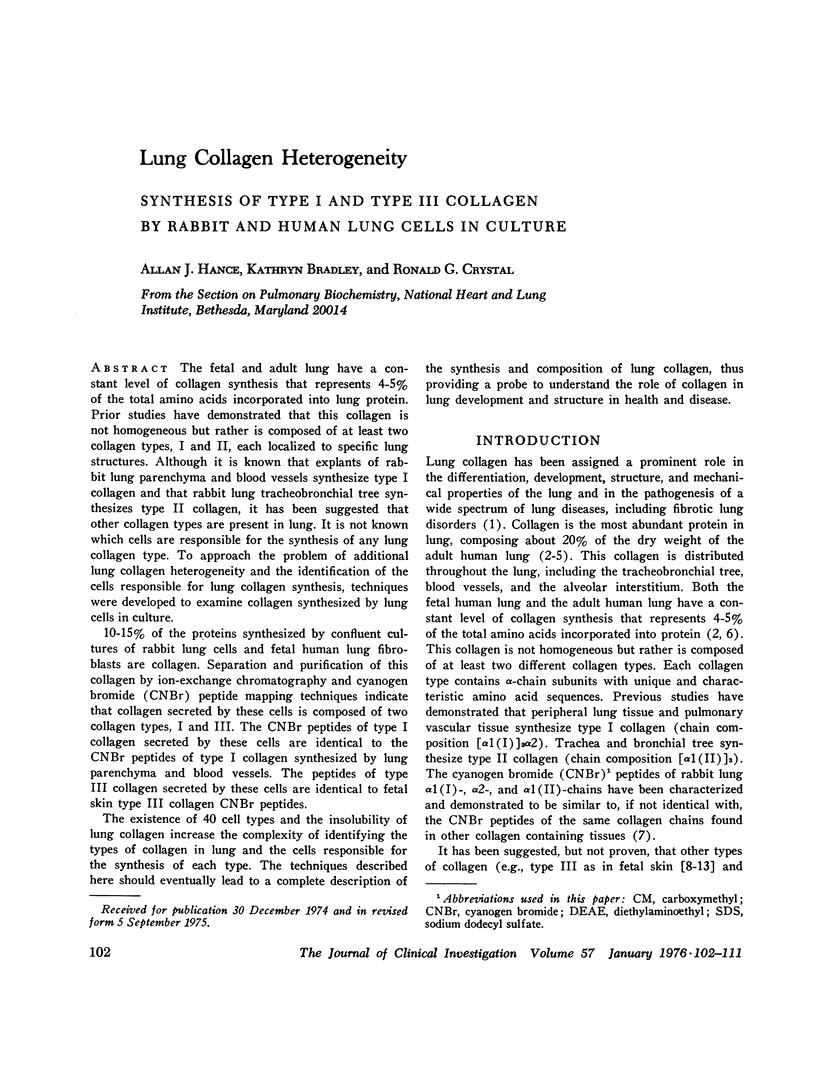
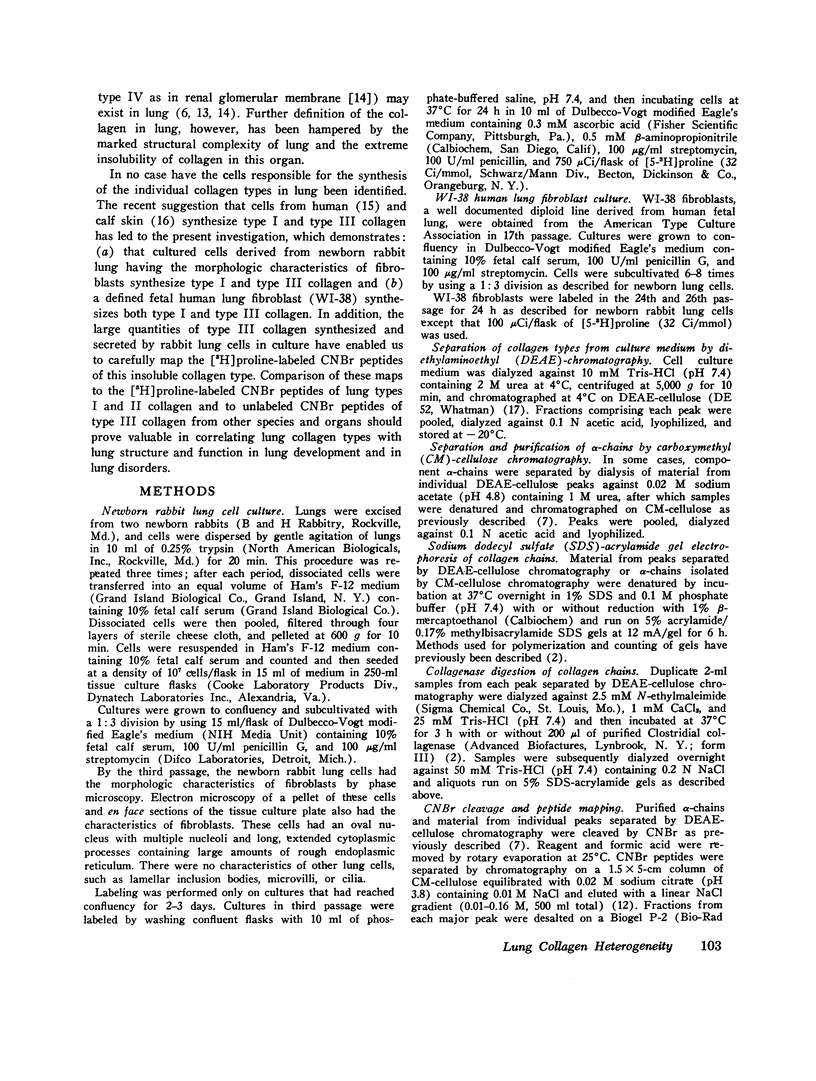


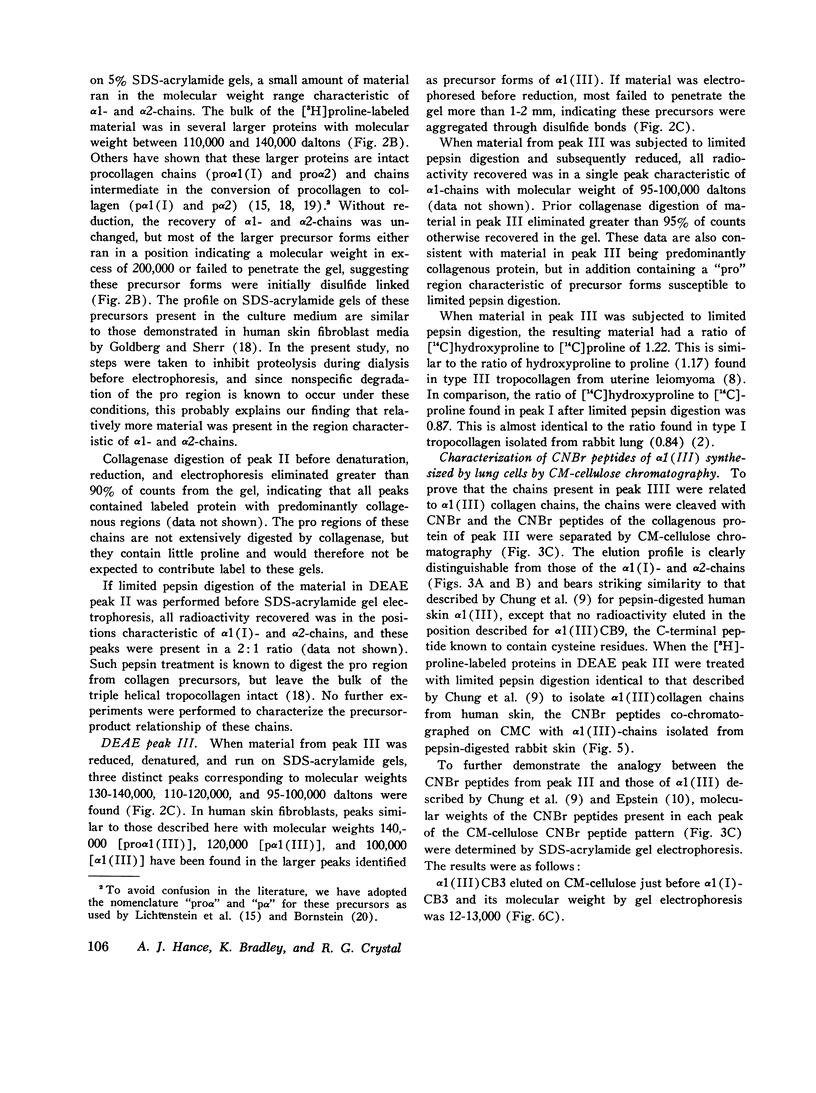

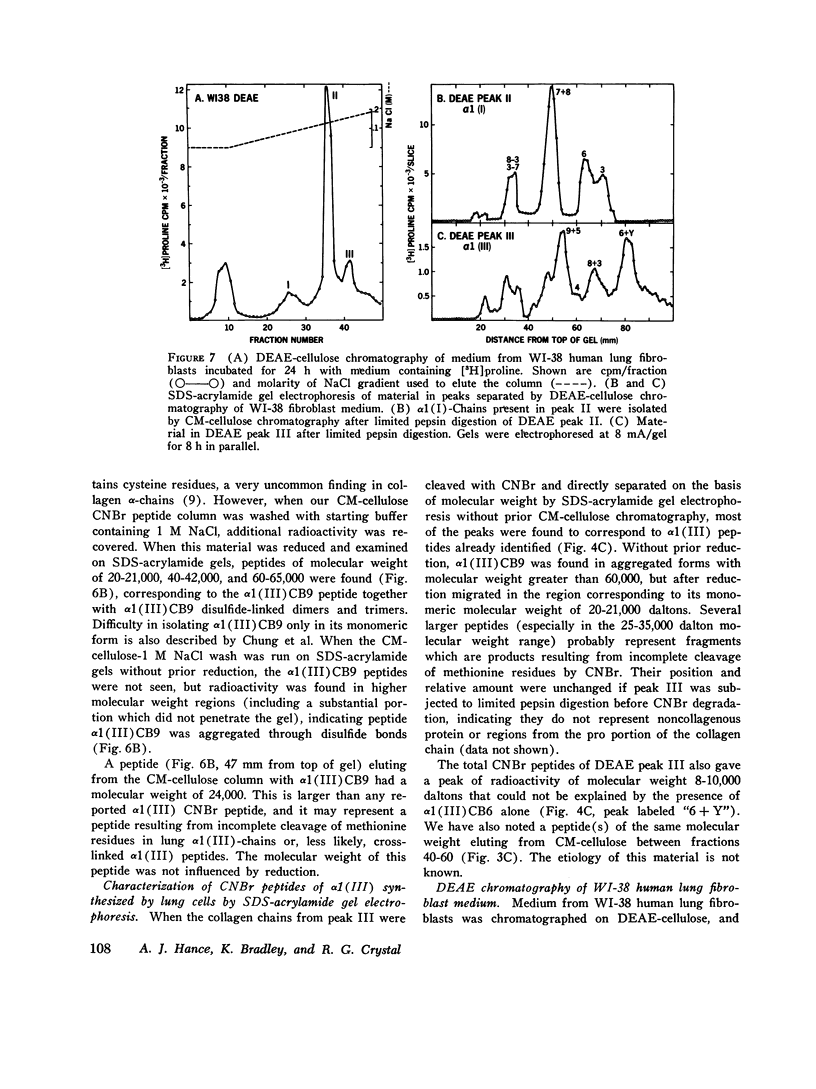
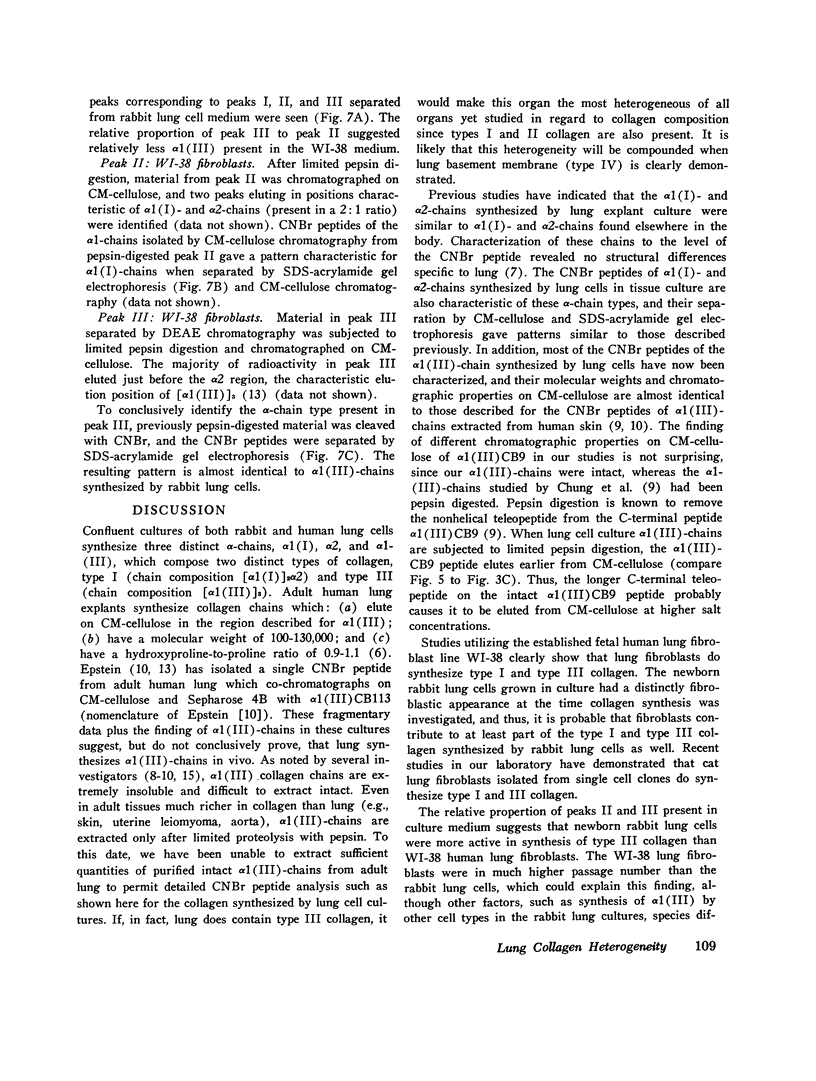
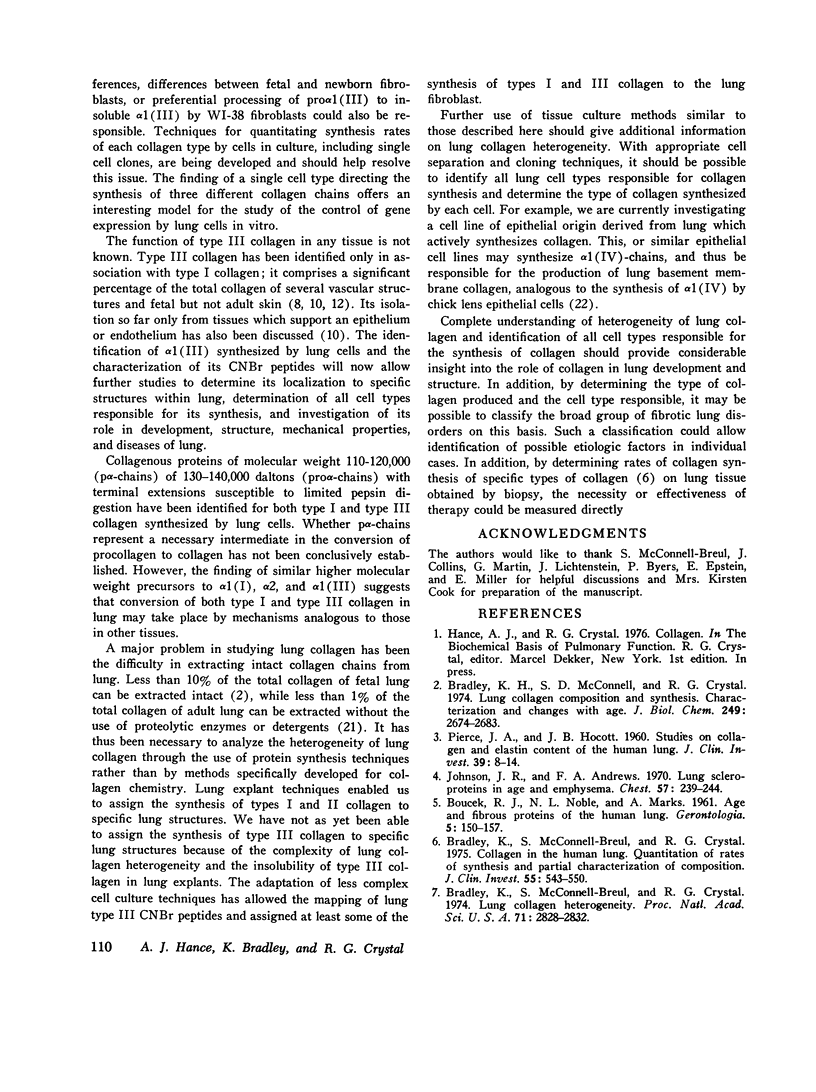

Selected References
These references are in PubMed. This may not be the complete list of references from this article.
- BOUCEK R. J., NOBLE N. L., MARKS A. Age and the fibrous proteins of the human lung. Gerontologia. 1961;5:150–157. doi: 10.1159/000211051. [DOI] [PubMed] [Google Scholar]
- Bornstein P. The biosynthesis of collagen. Annu Rev Biochem. 1974;43(0):567–603. doi: 10.1146/annurev.bi.43.070174.003031. [DOI] [PubMed] [Google Scholar]
- Bradley K. H., McConnell S. D., Crystal R. G. Lung collagen composition and synthesis. Characterization and changes with age. J Biol Chem. 1974 May 10;249(9):2674–2683. [PubMed] [Google Scholar]
- Bradley K., McConnell-Breul S., Crystal R. G. Collagen in the human lung. Quantitation of rates of synthesis and partial characterization of composition. J Clin Invest. 1975 Mar;55(3):543–550. doi: 10.1172/JCI107961. [DOI] [PMC free article] [PubMed] [Google Scholar]
- Bradley K., McConnell-Breul S., Crystal R. G. Lung collagen heterogeneity. Proc Natl Acad Sci U S A. 1974 Jul;71(7):2828–2832. doi: 10.1073/pnas.71.7.2828. [DOI] [PMC free article] [PubMed] [Google Scholar]
- Chung E., Keele E. M., Miller E. J. Isolation and characterization of the cyanogen bromide peptides from the alpha 1(3) chain of human collagen. Biochemistry. 1974 Aug 13;13(17):3459–3464. doi: 10.1021/bi00714a006. [DOI] [PubMed] [Google Scholar]
- Chung E., Miller E. J. Collagen polymorphism: characterization of molecules with the chain composition (alpha 1 (3)03 in human tissues. Science. 1974 Mar;183(130):1200–1201. doi: 10.1126/science.183.4130.1200. [DOI] [PubMed] [Google Scholar]
- Church R. L., Tanzer M. L., Lapiere C. M. Identification of two distinct species of procollagen synthesized by a clonal line of calf dermatosparactic cells. Nat New Biol. 1973 Aug 8;244(136):188–190. doi: 10.1038/newbio244188a0. [DOI] [PubMed] [Google Scholar]
- Crystal R. G. Lung collagen: definition, diversity and development. Fed Proc. 1974 Nov;33(11):2248–2255. [PubMed] [Google Scholar]
- Epstein E. H., Jr (Alpha1(3))3 human skin collagen. Release by pepsin digestion and preponderance in fetal life. J Biol Chem. 1974 May 25;249(10):3225–3231. [PubMed] [Google Scholar]
- Goldberg B., Epstein E. H., Jr, Sherr C. J. Precursors of collagen secreted by cultured human fibroblasts. Proc Natl Acad Sci U S A. 1972 Dec;69(12):3655–3659. doi: 10.1073/pnas.69.12.3655. [DOI] [PMC free article] [PubMed] [Google Scholar]
- Goldberg B., Sherr C. J. Secretion and extracellular processing of procollagen by cultured human fibroblasts. Proc Natl Acad Sci U S A. 1973 Feb;70(2):361–365. doi: 10.1073/pnas.70.2.361. [DOI] [PMC free article] [PubMed] [Google Scholar]
- Grant M. E., Kefalides N. A., Prockop D. J. The biosynthesis of basement membrane collagen in embryonic chick lens. I. Delay between the synthesis of polypeptide chains and the secretion of collagen by matrix-free cells. J Biol Chem. 1972 Jun 10;247(11):3539–3544. [PubMed] [Google Scholar]
- Johnson J. R., Andrews F. A. Lung scleroproteins in age and emphysema. Chest. 1970 Mar;57(3):239–244. doi: 10.1378/chest.57.3.239. [DOI] [PubMed] [Google Scholar]
- Kefalides N. A., Denduchis B. Structural components of epithelial and endothelial basement membranes. Biochemistry. 1969 Nov;8(11):4613–4621. doi: 10.1021/bi00839a057. [DOI] [PubMed] [Google Scholar]
- Lichtenstein J. R., Byers P. H., Smith B. D., Martin G. R. Identification of the collagenous proteins synthesized by cultured cells from human skin. Biochemistry. 1975 Apr 22;14(8):1589–1594. doi: 10.1021/bi00679a007. [DOI] [PubMed] [Google Scholar]
- PIERCE J. A., HOCOTT J. B. Studies on the collagen and elastin content of the human lung. J Clin Invest. 1960 Jan;39:8–14. doi: 10.1172/JCI104030. [DOI] [PMC free article] [PubMed] [Google Scholar]
- Smith B. D., Byers P. H., Martin G. R. Production of procollagen by human fibroblasts in culture. Proc Natl Acad Sci U S A. 1972 Nov;69(11):3260–3262. doi: 10.1073/pnas.69.11.3260. [DOI] [PMC free article] [PubMed] [Google Scholar]
- Trelstad R. L. Human aorta collagens: evidence for three distinct species. Biochem Biophys Res Commun. 1974 Apr 8;57(3):717–725. doi: 10.1016/0006-291x(74)90605-6. [DOI] [PubMed] [Google Scholar]
- Volpin D., Veis A. Cyanogen bromide peptides from insoluble skin and dentin bovine collagens. Biochemistry. 1973 Mar 27;12(7):1452–1464. doi: 10.1021/bi00731a028. [DOI] [PubMed] [Google Scholar]


